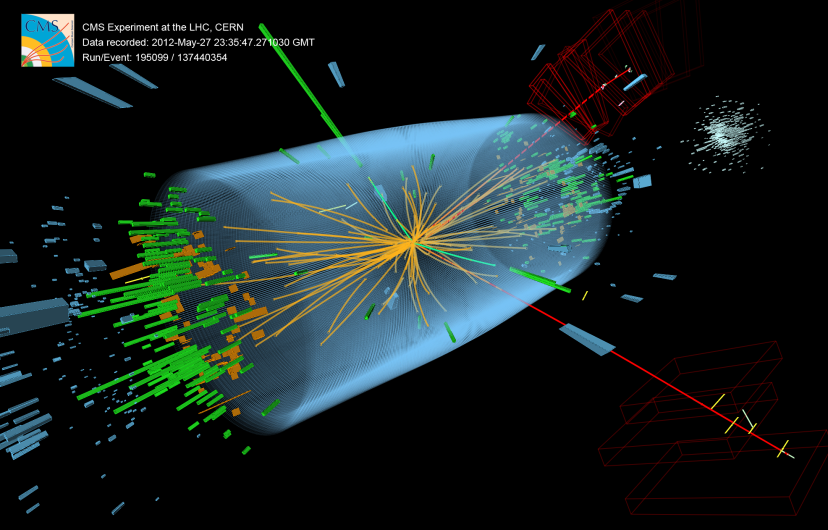Ten years ago, the Higgs boson was discovered
 Detection by the CMS experiment of a particle collision at the LHC, which contributed to the detection of the Higgs boson
Detection by the CMS experiment of a particle collision at the LHC, which contributed to the detection of the Higgs boson
On 4 July 2012, at CERN, the European Organization for Nuclear Research, the discovery of the Higgs boson was officially announced. This elementary particle, the latest observed to date, was a theoretical prediction made 48 years earlier, among others by physicist Peter Higgs. To mark this anniversary, CERN is organising an international symposium, broadcast live from the Laboratoire Leprince-Ringuet (LLR*).
The LLR and the Center for Microelectronics (OMEGA*) are among the many laboratories that took part in this discovery, which was made thanks to the LHC, the world's largest particle accelerator located at CERN, on the French-Swiss border. In an underground ring 27 km in circumference, bunches containing billions of protons - hydrogen nuclei - are accelerated and collide at a frantic pace. These collisions release energy, which is converted into a host of other particles. It is these particles that physicists watch out for, thanks to the gigantic detectors placed along the ring, such as the CMS experiment. One of the designers of this experiment was Michel Della Negra (X1961, now emeritus professor at Imperial College London) and the LLR is playing a very active role in it.
Several discoveries
By analysing the huge amount of data from these collisions, the researchers finally detected the Higgs boson, thus completing the Standard Model of particle physics, which is the theory that best describes the microscopic world today. The Standard Model explains the particles that make up matter (fermions), but also the interactions (electromagnetism, strong and weak nuclear forces) that are due to exchanges of particles called bosons.
" It was very exciting," recalls Yves Sirois, physicist and director of the LLR. But one should say discoveries, plural". On the one hand, the Higgs boson is linked to a particular moment of the history of the Universe, a fraction of a second after the Big Bang, when the electromagnetic and weak nuclear interactions, which were still one and the same thing, split. In 2012, this mechanism was confirmed. On the other hand, in the years that followed, scientists measured more precisely how the Higgs boson interacts with other particles of matter, in a way that is consistent with their mass. Indeed, it is by interacting with the Higgs boson that elementary particles acquire their mass.
The search for new physics continues
Nevertheless, while these discoveries have confirmed many aspects of the theory, the story of particle physics is far from over. For example, several measurement anomalies are not understood. Also, the current theory does not predict certain parameters, such as the mass of the Higgs boson, suggesting that there is something beyond. For Roberto Salerno, physicist at LLR, "there could be a link between the Higgs boson and the new physics. This boson could, for example, disintegrate into dark matter, a component of the Universe whose nature is unknown."
On 5 July, the LHC will begin a new measurement campaign after upgrades. Among other things, this will involve measuring the coupling of the Higgs boson to other particles of matter with ever greater precision and making progress towards measuring its self-coupling, which is linked to the very nature of the quantum vacuum that surrounds us. This is a long-term task, and this measurement in particular will require a new upgrade of the LHC, starting in 2026, on which the LLR and OMEGA are already working.
Additional information:
On Wednesday 6 July 2022, a scientific conference will be held in Paris, organised by IN2P3, dedicated to the Higgs boson. Yves Sirois will speak at 10:50 am.
Location: Amphi Buffon (rue Hélène Brion, 75013), 9h30-12h30, followed by a cocktail at the Bateau-Phare .
There are still places available and you can still register for this event here
A broadcast will also take place from the LLR conference room.
*LLR: a joint research unit CNRS, École Polytechnique - Institut Polytechnique de Paris
*OMEGA: a joint service unit CNRS, École Polytechnique - Institut Polytechnique de Paris
 Support l'X
Support l'X